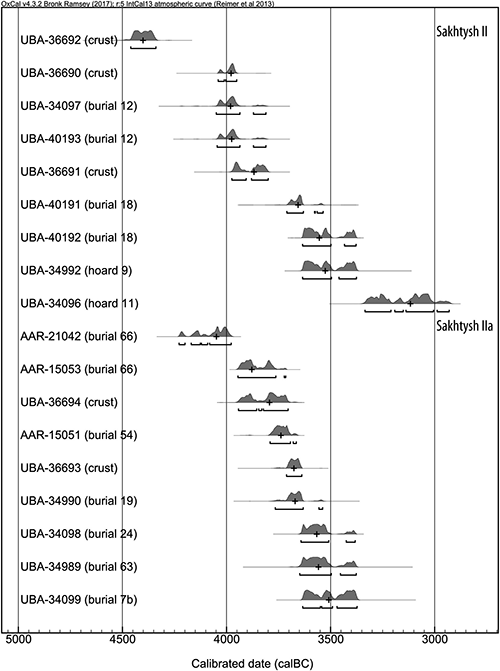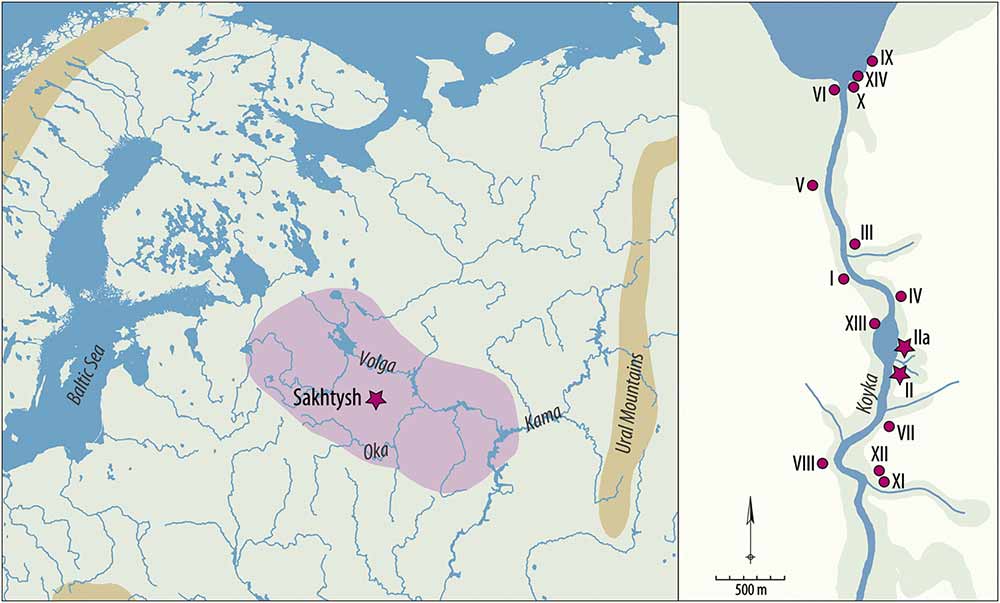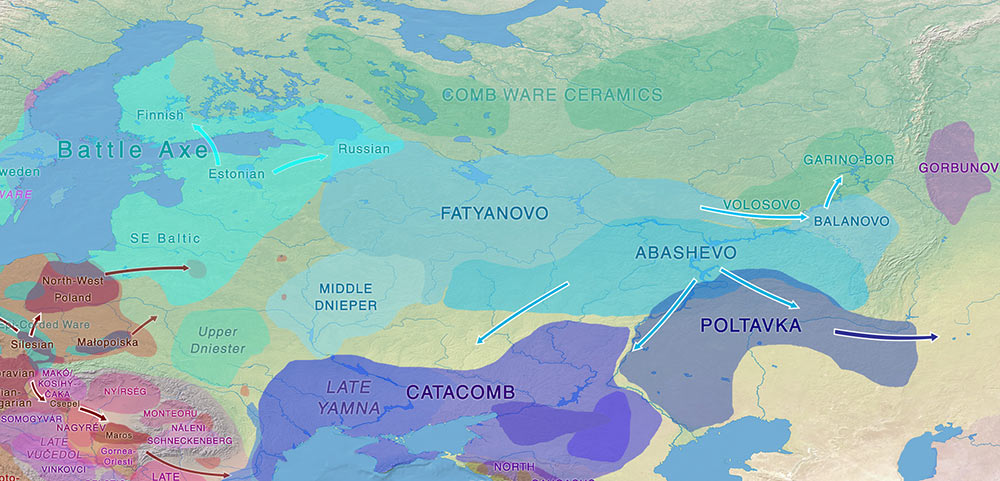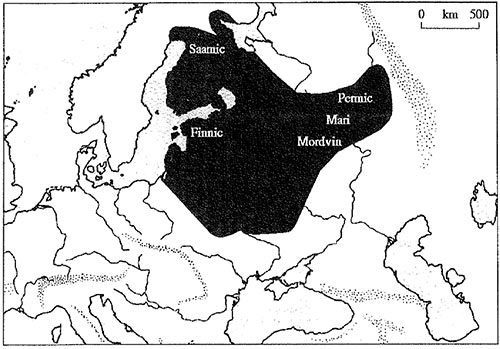Recent paper (behind paywall) Marmot incisors and bear tooth pendants in Volosovo hunter-gatherer burials. New radiocarbon and stable isotope data from the Sakhtysh complex, Upper-Volga region, by Macānea, Nordqvist, and Kostyleva, J. Archaeol. Sci. (2019) 26:101908.
Interesting excerpts (emphasis mine):
The Sakhtysh micro-region is located in the Volga-Oka interfluve, along the headwaters of the Koyka River in the Ivanovo Region, central European Russia (Fig. 1). The area has evidence of human habitation from the Early Mesolithic to the Iron Age, and includes altogether 11 long-term and seasonal settlements (Sakhtysh I–II, IIa, III–IV, VII–XI, XIV) and four artefact scatters (sites V–VI, XII–XIII), in addition to which burials have been detected at five sites (I–II, IIa, VII, VIII) (Kostyleva and Utkin, 2010). The locations have been known since the 1930s and intensively studied since the 1960s under the leadership of D.A. Kraynov, M.G. Zhilin, E.L. Kostyleva, and A.V. Utkin.
Sakhtysh II and IIa are the most extensively studied sites of the complex, with ca. 1500m2 and around 800m2 excavated, respectively. The burial grounds at both sites are considered as fully investigated.

residues on pottery from cultural layer. For data, see Tables 1–2.
Sakhtysh chronology
The AMS dates do not support the previously proposed phasing of the Sakhtysh burials to early (4750–4375 BP/3600–3000 cal BCE), late (or developed; 4375–4000 BP/3000–2500 cal BCE), and final (4000–3750 BP/2500–2200 cal BCE): the early and late burials at Sakhtysh IIa do not stand out as two separate groups, and also the burials and hoards from Sakhtysh II, connected to the final phase, are temporally overlapping with these. Neither the use sequence, where the settlement and burial phases are non-overlapping and also complementary between the sites (Kostyleva and Utkin, 2010, 2014), finds support in the present material.
The AMS datings indicate that the Volosovo people started to bury their dead at Sakhtysh IIa after 3700 cal BCE; dates earlier than this may be affected by FRE or suffer from mixed contexts and poor quality of dates. The present data questions the interpretation that the Sakhtysh IIa cemetery was used without interruptions between 4800 and 4080 BP (Kostyleva and Utkin, 2010), i.e. for a millennium between 3550 and 2600 cal BCE. The AMS dates rather suggest a use period of some centuries only around the mid-4th millennium cal BCE, tentatively 3650–3400 cal BCE. This would also be more realistic considering the number of burials at the site.

Volosovo chronology
The absolute dating of Volosovo culture was for a long time hampered by the small number of radiocarbon dates (see Kraynov, 1987). Today,>100 datings connected with it can be found in literature (Korolev and Shalapinin, 2010; Chernykh et al., 2011; Nikitin, 2012; Mosin et al., 2014). Unfortunately, the available dates do not form solid grounds for dating the cultural phenomenon, as many of them have quality-related issues, large measurement errors, and ambiguous cultural or physical contexts. Consequently, particular datings may be connected to different cultural phases by different scholars. Finally, a large part of the newly-published datings are obtained through direct dating of potsherds (Kovaliukh and Skripkin, 2007; Zaitseva et al., 2009), and therefore, their cogency must be faced with reservation (see Van der Plicht et al., 2016; Dolbunova et al., 2017).
The datings connected with Volosovo cover a wide time range between ca. 5500 BP (4400 cal BCE) and ca. 3700 BP (2100 cal BCE). However, datings from secure contexts, with good quality (error ca. 50 years or below) and no probable FRE, place the beginning of Volosovo culture to the first half of the 4th millennium cal BCE, around 3700–3600 cal BCE. This is also supported by the roughly coeval terminal dates given for the preceding Lyalovo (Zaretskaya and Kostyleva, 2011) and Volga-Kama cultures (Lychagina, 2018), as well as the appearance of related neighbouring cultures, for example, in the Kama region (Nikitin, 2012; Lychagina, 2018), the southern forest steppe area (Korolev and Shalapinin, 2014), and north-western Russia and Finland (Nordqvist, 2018). Still, the dating of many of these cultural phases suffers from the same problems as of Volosovo.
A handful of contested datings place the end of Volosovo culture to the final centuries of the 3rd millennium cal BCE, or even later (Kostyleva and Utkin, 2010; Chernykh et al., 2011; Nikitin, 2012). On the other hand, the new AMS dates indicate that Volosovo activities at Sakhtysh II and IIa ceased before or towards the early 3rd millennium cal BCE; if this reflects the general decline of Volosovo culture must be still confirmed by more dates from Sakhtysh and elsewhere. In this context, the general cultural development must be accounted for. To what extent – if at all – the Volosovo people were present after the arrival of the Corded Ware culture-related Fatyanovo-Balanovo populations? Based on the current, albeit scant and inconclusive radiocarbon data this took place from ca. 2700 cal BCE onwards (Krenke et al., 2013).

Comments
One of the interesting genetic papers in the near future will be the one that finally includes samples from Corded Ware groups in the forest zone (i.e. Fatyanovo-Balanovo and Abashevo), which will most likely confirm that they are the origin of the known genetic profile of Central and East Uralic-speaking peoples, seeing how West Uralic peoples show genetic continuity in the East Baltic area, coinciding with the Battle Axe culture.
Uralicists have come a long way from the 1990s, when the picture of Uralic before Balto-Slavic in the Baltic was already evident, and Uralians were identified with Comb Ware peoples. The linguistic data and relative chronology are still valid, despite the now outdated interpretations of absolute archaeological chronology, as happens with interpretations of Krahe or Villar about Old European.
As an example, here are some relevant excerpts from Languages in the Prehistoric Baltic Sea Region, by Kallio (2003):
NOTE. Kallio’s contribution appeared in the book Languages in Prehistoric Europe (2003), which I hold nostalgically close in my Indo-European library (now almost impossible to read fully). It is still one of my preferred books (from those made up of mostly unconnected chunks on European linguistic prehistory), because it contains Oettinger’s essential update of North-West Indo-European common vocabulary, which led us indirectly to our Modern Indo-European project from 2005 on.
In any case, the Uralic arrival in the region east of the Baltic Sea preceded the Indo-European one (…).
This theory that the ancestors of Finno-Saamic speakers arrived in the Baltic Sea region earlier than those of Balto-Slavic speakers is still rejected by some scholars (e.g. Napolskikh 1993: 41-44), who claim, for instance, that Finno-Saamic speakers would not have known salmons before they met Balts because the Finno-Saamic word for ‘salmon’ (i.e. *losi) is a borrowing from Baltic. Similarly, one could claim that English speakers would not have known salmons before they met Frenchmen because English salmon is a borrowing from French. In other words, Worter und Sachen are not necessarily borrowed hand in hand. Otherwise, it would not be so easy to explain how many Finnish names of body parts are borrowings from Baltic (e.g. hammas ‘tooth’, kaula ‘neck’, reisi ‘thigh’) and from Germanic (e.g. hartia ‘shoulder’, lantio ‘loin’, maha ‘stomach’).
A more probative argument is the fact that Balto-Slavic features in Finno-Saamic are mostly lexical ones (i.e. typical superstrate features), where Finno-Saamic features in Balto-Slavic are mostly non-lexical ones (i.e. typical substrate features). Note that there are more Balto-Slavic features in Finnic than in Saamic and more Finno-Saamic features in Baltic than in Slavic. This fact could be explained by presuming that Pre-Saamic was spoken north of the Corded Ware area and Pre-Slavic was spoken south of the Typical Pit-Comb Ware area, whereas Pre-Finnic and Pre-Baltic alone were spoken in the area, where both the Typical Pit-Comb Ware culture (ca. 4000-3600 BC) and the Corded Ware culture (ca. 3200-2300 BC) were situated. This area was most probably bilingual, until Finnic and Baltic won in the north and in the south, respectively.
As is well-known, the idea of Uralic substrate features in Balto-Slavic is not new (cf. e.g. Pokorny 1936/1968: 181-185). As recent studies (e.g. Bednarczuk 1997) have shown, their density is the most remarkable in the four Balto-Slavic languages spoken in the earlier Pit-Comb Ware area (i.e. Latvian, Lithuanian, Belorussian, Russian). On the other hand, occasional Uralisms in the other Balto-Slavic languages spoken west of the Vistula and south of the Pripyat may rather be considered adstrate features spread from the northeast.

The idea of Indo-European superstrate features in Finnic is not new either (cf. e.g. Posti 1953). As Jorma Koivulehto (1983) has recently shown, the earliest Indo-European loanword stratum in the westernmost Uralic branches alone can be considered Northwest Indo-European and connected with the Corded Ware culture (ca. 3200-2300 BC). Since this layer, there have been continuous contacts between Baltic and Finnic. According to Koivulehto (1990), the following stratum can be called Proto-Balt(o-Slav)ic and dated to the Late Neolithic period (ca. 2300-1500 BC). Note that this Proto-Balt(o-Slav)ic dating agrees with the established ones (cf. e.g. Shevelov 1964: 613-614, Kortlandt 1982: 181), when we remember the fact that archaeologists have also moved their datings back by centuries during the last decades.
Finally, there is also a Baltic loanword stratum which was not borrowed from the ancestral stage of Latvian, Lithuanian and/or Old Prussian but from some extinct Baltic language or dialect (Nieminen 1957). However, as these words still go back to the early Proto-Finnic stage, they can hardly be dated later than Bronze-Age ( ca. 1500-500 BC). Therefore, we may conclude that they were probably borrowed from a Baltic superstrate, which arrived in the Finnish Gulf area during the Corded Ware period and survived there until the Bronze Age, when it was no longer identical with other Baltic dialects. In any case, as later Baltic loanword strata concern southern Finnic languages alone, we may presume that this ‘North Baltic’superstrate had become extinct.
The traditional association of Uralic with Volosovo hunter-gatherers doesn’t make sense, since they neither miraculously survived for thousands of years nor mixed for hundreds of years with Corded Ware peoples, so we can now more confidently reject the recent assumption by Carpelan & Parpola that their language was adopted by incoming Fatyanovo, Balanovo and Abashevo groups, to develop into the known Uralic languages (more here). This includes one of the many models of the the Copenhagen group, who simplistically follow “Steppe ancestry” for Indo-Europeannes.
If one combines the known relative linguistic chronology with the North-West Indo-European hydrotoponymy layer, now more clearly identified as Old Europeans expanding with East Bell Beakers and derived Early Bronze Age groups, I think there is little space left for maneuvering out of the overwhelming evidence for a Uralic homeland in the forest-steppes, linked to the spread of late Sredni Stog/Corded Ware ancestry into north-eastern Europe and beyond the Urals.
Related
- Genetic continuity among Uralic-speaking cultures in north-eastern Europe
- European hydrotoponymy (I): Old European substrate and its relative chronology
- Uralic speakers formed clines of Corded Ware ancestry with WHG:ANE populations
- The cradle of Russians, an obvious Finno-Volgaic genetic hotspot
- Pre-Germanic and Pre-Balto-Finnic shared vocabulary from Pitted Ware seal hunters
- Balto-Slavic accentual mobility: an innovation in contact with Balto-Finnic
- Common Slavs from the Lower Danube, expanding with haplogroup E1b-V13?
- “Dinaric I2a” and the expansion of Common Slavs from East-Central Europe
- The significance of the Tollense Valley in Bronze Age North-East Germany
- Aquitanians and Iberians of haplogroup R1b are exactly like Indo-Iranians and Balto-Slavs of haplogroup R1a
- Pre-Germanic born out of a Proto-Finnic substrate in Scandinavia
- On Proto-Finnic language guesstimates, and its western homeland
- On the origin and spread of haplogroup R1a-Z645 from eastern Europe